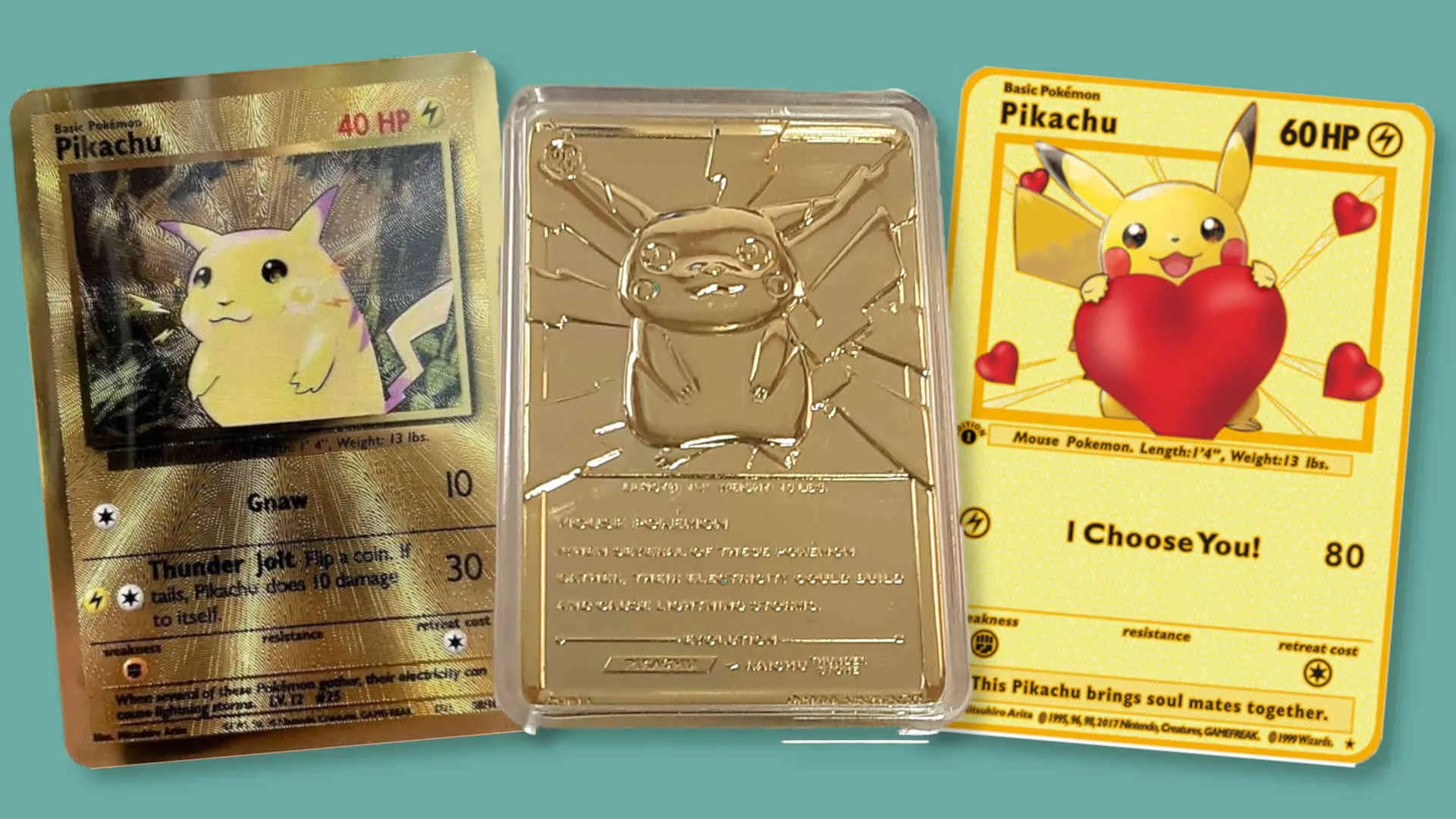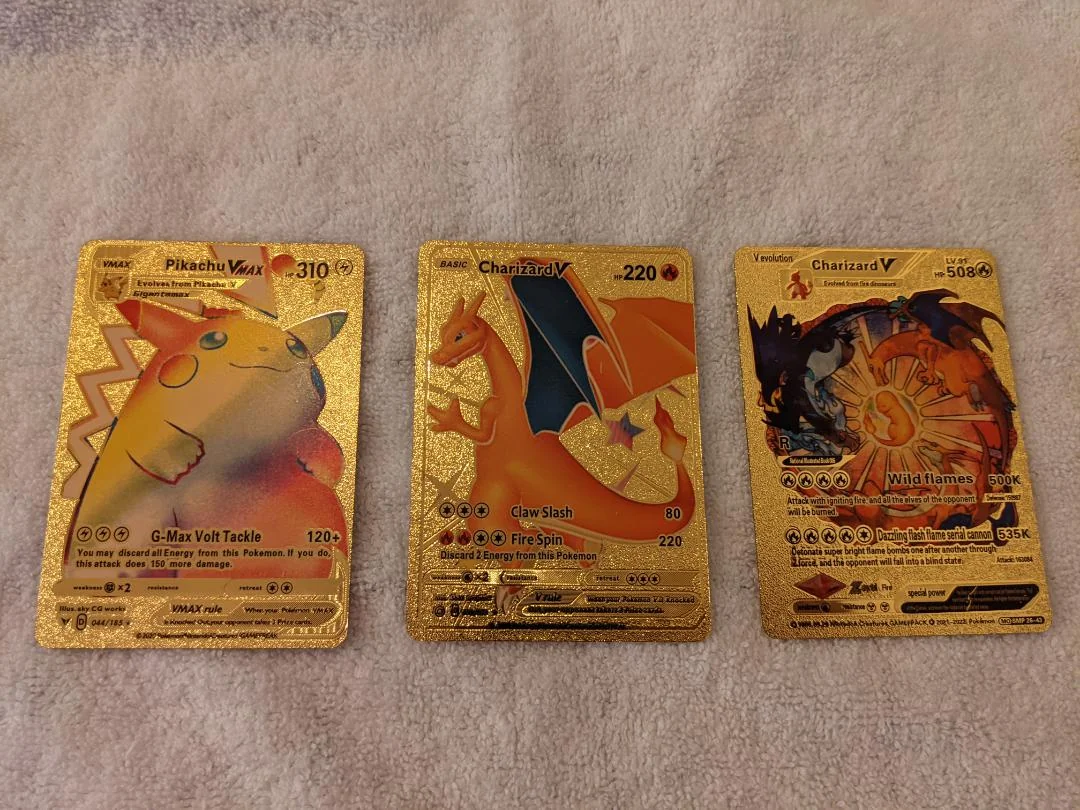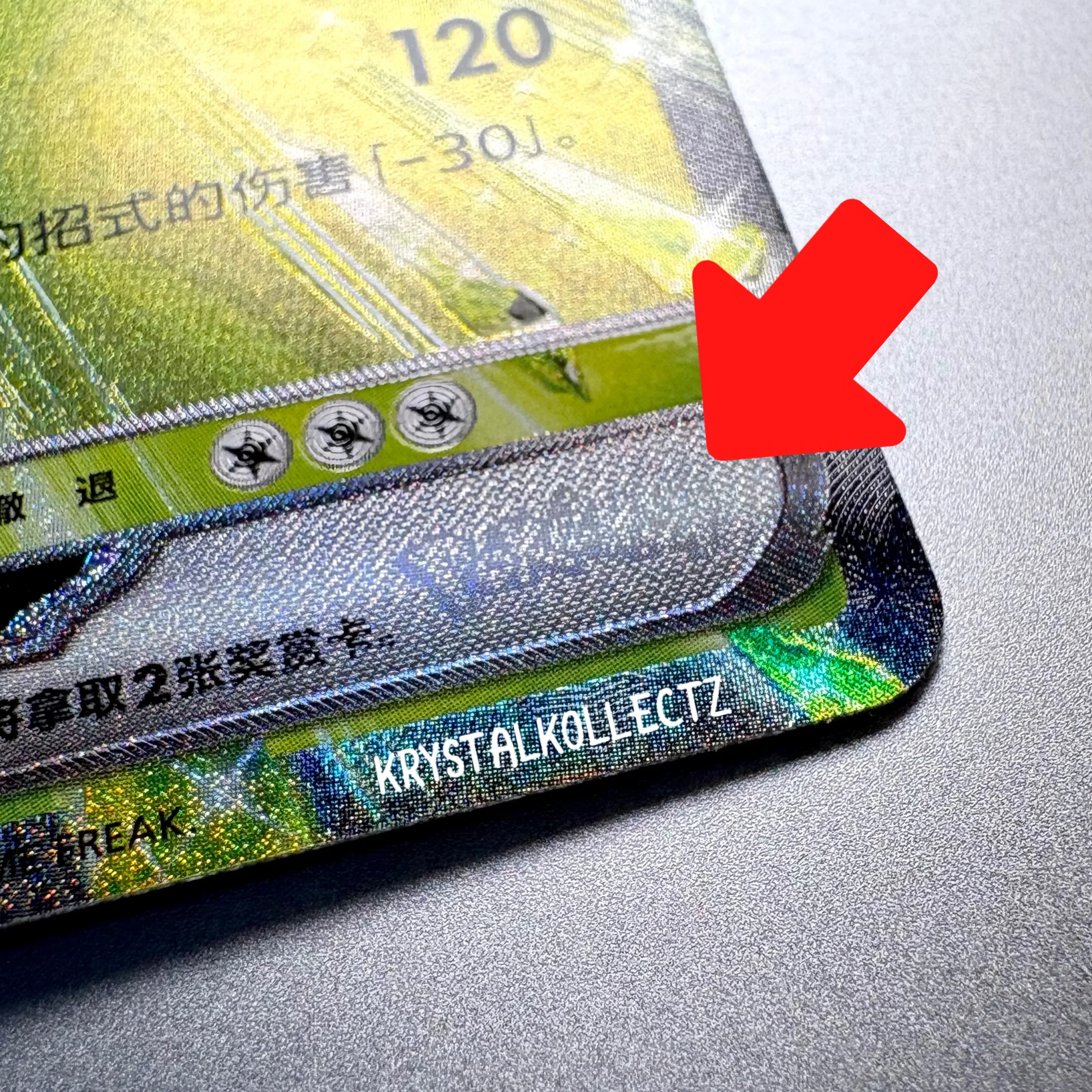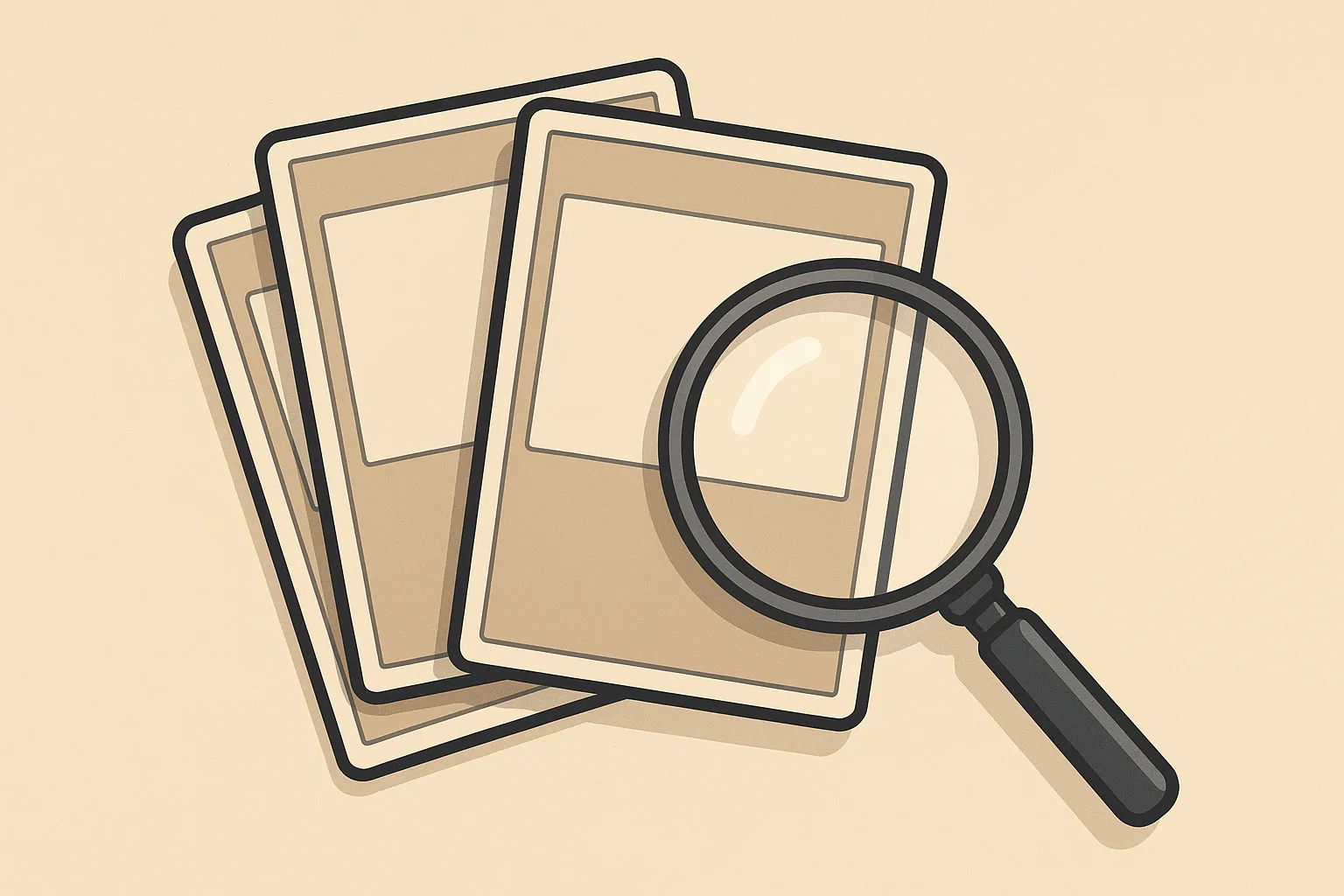Fake Pokémon cards are everywhere: online marketplaces, sketchy “mystery boxes”, flea markets – even mixed into bulk lots. Some bootlegs are laughably bad, others are so convincing that even experienced collectors need a closer look.
This guide shows you step by step how to spot fake Pokémon cards and products – including:
- English & international cards
- Japanese cards
- Simplified Chinese cards
- Boosters and booster boxes
- Proxies vs. real counterfeits
1. What counts as a fake card?
In this guide, fake cards means:
- Counterfeits – cards printed to imitate official Pokémon cards and sold as if they were real.
- Tampered products – real products that have been opened, resealed or otherwise manipulated (e.g. resealed booster boxes).
These are not tournament legal and should never be sold as official cards.
Separate from that are proxies and custom cards: fan-made cards that are (ideally) clearly marked as unofficial and used for casual play or testing. They’re fine as long as nobody tries to sell them as real product.
2. Universal checks – works on every Pokémon card
These tests work on almost every Pokémon card, no matter the language or era.
2.1 Feel & stiffness
Hold the card between your fingers and gently flex it:
- Real Pokémon cards feel sturdy but not plasticky.
- They bend slightly and spring back into shape.
- Many fakes feel:
- too thin and flimsy, or
- too thick and rigid, like cheap playing cards.
2.2 Print quality & colours
Look closely at the artwork and the text:
- Real cards
- have sharp lines and clean details,
- use rich but balanced colours,
- show smooth gradients in the background.
- Fake cards often
- look blurry or pixelated,
- have colours that are too bright, too dark or with a weird tint,
- show a visible “fabric” texture or dot pattern even without a magnifying glass.
If you own a confirmed real copy of the same card, compare them side by side – differences jump out immediately.
2.3 Text, fonts & spelling
Pokémon cards use very consistent fonts and layout. Red flags:
- Spelling mistakes and broken English
(e.g. “filp”, “trun”, “damge”, “doen”). - The word “Pokémon” without the accent é where it should be.
- Fonts that are too thick, too thin or inconsistent on the same card.
- Weird spacing (kerning) – letters too far apart or overlapping.
Always read attack text, ability text and flavour text. Counterfeiters copy artwork more carefully than they copy the rules box.
2.4 Symbols, numbers & layout
Many bootlegs mess up the gameplay details:
- HP values in the thousands or other numbers that don’t exist.
- Wrong type symbol for that Pokémon.
- Set symbol and rarity symbol that do not match the real card.
- Fake “1st Edition / 2nd Edition” stamps.
- Card numbers like
151/150that don’t exist in that set, or wrong rarity tags (e.g. CHR on a card that isn’t a Character Rare).
When in doubt, look up the card in a card database and compare: name, HP, attacks, weakness, resistance, retreat, card number and rarity.
2.5 The card back – real vs. fake
The back is one of the easiest ways to catch fakes.

Check:
- Colour of the blue border
- Real: deep blue with subtle darker “splashes”.
- Fake: flat, single-tone blue, too bright or too purple.
- Poké Ball & logo
- Real: crisp outlines, clean yellow logo.
- Fake: fuzzy outlines, dull yellow, wrong outline thickness.
- Edge alignment
- Real: borders roughly even.
- Fake: often very off-centre combined with wrong colour/texture.
Always compare with a card you know is real.
2.6 Light test
Hold the card right against a strong light (phone flashlight):
- Real Pokémon cards use layered cardstock with a special core.
- You see soft, diffused light passing through – but not totally transparent.
- Many fakes are either
- almost see-through, like cheap paper, or
- block the light completely, because of different materials.
This test is even more helpful when you compare real and suspect cards side by side.
2.7 Rip test (only as a last resort)
The rip test destroys the card – only use it on cards you are prepared to sacrifice.
Tear the card cleanly in half:
- English & most international prints
→ real cards show a thin black or dark-grey core layer in the middle. - Japanese prints
→ real cards show a dark blue inner layer.
If there is no coloured core layer at all, the card is almost certainly fake.
3. How to spot fake English & international cards
Most counterfeits online imitate English cards, so it’s worth knowing the details.
3.1 Texture & holo pattern

Check:
- Real modern holos (GX, V, VMAX, VSTAR, full arts, alt arts)
- have embossed texture you can feel with your fingertip,
- holo pattern moves smoothly when you tilt the card.
- Fakes
- often have flat surface where the “texture” is just printed,
- holo can look dull, muddy or extremely rainbow-ish in the wrong way.
3.2 Edges, corners & warping

- Real cards:
- clean, smooth edges,
- evenly rounded corners,
- mild curvature over time is normal (especially holos), but not extreme warping straight from the seller.
- Fakes:
- rough or fuzzy edges,
- inconsistent corner radius,
- sometimes arrive already heavily warped.
Warping alone doesn’t prove a fake, but combined with other signs it’s a strong indicator.
3.3 Common “lazy” mistakes on English fakes
Look out for these:
- Wrong weakness/resistance type or number.
- Energy costs that don’t match the real version of the card.
- Attack text that is pure nonsense or copied from the wrong card.
- Mix of generations: Sword & Shield layout with an XY or Sun & Moon set symbol, old EX border with modern card text, etc.
- Misaligned or missing regulation marks (the small [D], [E], [F] etc. on modern cards).
If anything seems “off” when you read the card like a real game piece, treat it as suspicious.
3.4 “These cards are all fake” – over-the-top gold cards
There is one group of cards that you can safely treat as 100% fake every single time: the over-the-top full-gold cards you often see on marketplaces and in cheap bundles.


- Full-gold or plastic – the entire card is gold coloured, often on a plate. Official cards are always printed on layered cardstock, not thick.
- No normal card layout – attack boxes, weakness, retreat cost and regulation mark are missing or randomly placed. Sometimes the whole front is just artwork with a huge logo.
- Missing legal text and set info – there is no proper set symbol, set code, card number or copyright line at the bottom.
- Extreme stats and fan text – made-up HP values (thousands), fake rarities or completely invented attacks.
These gold cards can be fun as novelty items or display pieces, but they are not tournament legal, not produced by Pokémon and have no collectible value in the official TCG. If someone tries to sell them to you as “real secret rares” – walk away.
4. How to spot fake Japanese cards
Japanese cards are printed with very high quality. Once you know how real ones look and feel, fakes stand out quickly.
4.1 Print quality & fonts
- Real Japanese cards:
- extremely sharp kanji and kana,
- consistent font weight and spacing,
- crisp energy and set symbols.
- Fakes:
- blurry or jagged kanji,
- strokes too thick or thin,
- strange spacing, wrong alignment in attack boxes.
Compare the suspect card to a Japanese card you opened yourself – even from another set – and look at the text under magnification.
4.2 Size, edges & corners
- Official size: 63 × 88 mm, same as English.
- Corners: neatly rounded, no “almost square” corners.
- Edges: very clean cut, with a tiny glossy feel.
Many fakes are slightly off in size or have rough, feathered edges from bad cutting.
4.3 Holo pattern & surface
- Real Japanese holos:
- strong and defined textures on full arts,
- very consistent reverse holo patterns (dots, lines, confetti, etc.),
- colours stay rich even under different lighting.
- Fakes:
- holo looks like a flat foil sticker,
- strange generic patterns that do not match the set,
- surface can feel either too plastic or too papery.
Again, side-by-side comparison is king here.
5. How to spot fake Simplified Chinese cards
For a long time, many collectors thought “Chinese cards = fake”. That’s no longer true. Since 2022, Pokémon prints official Simplified Chinese cards for Mainland China.
The challenge is to tell real Simplified Chinese from bootlegs.
5.1 Official Simplified vs. Traditional Chinese
- Simplified Chinese
- Mainland China, marked with codes like
CSM,CSL, etc. - Printed in Japan, similar feel to Japanese cards.
- Mainland China, marked with codes like
- Traditional Chinese
- Taiwan / Hong Kong releases.
- Different product line, no embossed logo on holos (see below).
Both are official. The presence or absence of an embossed logo alone does not mean “fake” – it depends on which language version the card belongs to.
5.2 Security features on real Simplified Chinese holos
On genuine Simplified Chinese holo cards you typically see two extra security features:
- Embossed Pokémon logo – bottom left
A small Pokémon logo is pressed into the card. You can feel it when you run your finger over it – it’s not just printed. - Lenticular security box – bottom right (on higher rarities)
This small holo box changes when you tilt the card: from a fine “holo dust” pattern to a brighter highlight or symbol depending on the angle.
Now look at the bottom right of the card in the photos below:


Bootlegs often skip these security features or only print a flat image that doesn’t change when you tilt it.
Some major signs of legitimacy to look out for include:
– A holographic circular sticker on the packaging. This sticker will display the official English & S-Chinese Pokemon logos along with a number beneath them (which seems to be unique for each individual item – even booster boxes of the same set will each have different numbers). These holographic stickers are also found on tags of official Pokemon plushies from Mainland China and packaging of collectible figures


5.3 Set codes, rarity & print quality

Check:
- Set codes – for example
CSM2c,CSVL1, etc. – and card numbers like151/150 CHR.
Look them up in a reliable database or store list to make sure they exist. - Pokémon logo stamp – bottom left – on real Simplified Chinese holo and higher-rarity cards (V, VMAX, ex, CHR, SAR, etc.) you will see a small embossed Pokémon logo in the lower left of the card frame. You can feel it with your fingertip.
If a card should be holo/CHR but has no stamp at all, or the stamp is just printed flat, that’s a big red flag. - Borders & silver foiling – real cards have uniform silver borders and smooth foil application.
- Text quality – characters are sharp, spacing consistent, no broken strokes.
If the security logos are missing and the card number / set code doesn’t exist anywhere, it’s almost certainly fake.
6. How to spot fake boosters & booster boxes
Counterfeiters don’t just fake single cards – they also fake sealed product.
6.1 General box checks (all languages)
Things to check on sealed booster boxes:
- Shrink-wrap quality
- Real boxes have neat, even shrink-wrap.
- On many Western boxes the plastic has repeated Pokémon logos printed into it.
- Fakes often have messy folds, random seams or melted spots from a heat gun.
- Air holes
- Real wraps usually have tiny perforation holes so the plastic doesn’t balloon.
- 100% perfectly smooth wrap with no air holes at all can be suspicious.
- Print quality on the box
- Logos and text should be crisp.
- Blurry logos, incorrect set name, or off colours are big red flags.
- Bottom of the box
- Check the barcode, product codes and copyright line – compare them with a confirmed real box image.
6.2 Japanese booster boxes
Japanese boxes have some very specific tells.
Common signs of fake or resealed JP boxes:
- Seam position
- On many official boxes the main seam does not run straight across the middle of the front.
- Fake wraps often have a big straight seam line in odd places.
- Zip strip alignment
- Official boxes with a tear strip have the plastic seam positioned so the strip works cleanly.
- If the zip strip looks misaligned or partly covered by another seam, be careful.
- Wrap tension
- Real wraps are snug but not crazy tight.
- If the box is bending inwards from plastic tension, or if the top surface looks wrinkly and loose, it could be a reseal.
If you can, compare your box with high-quality pictures of the same product from a trusted seller.
6.3 Booster packs
For individual packs, check:
- Seals
- Real packs have very regular crimping on top and bottom.
- Fakes or reseals show uneven or “chewed-up” crimps, or they don’t line up with the artwork.
- Printing
- Text, age rating, logos and barcodes should be sharp.
- Misspellings or strange product names (“Super Mystery Booster Pack EX GX VMAX MIX”) are dodgy.
- Pack size & amount of air
- Very puffy packs or extremely flat packs can indicate resealing, especially when combined with bad crimps.
If the set name on the pack doesn’t match any real release, treat it as fake.
7. Proxies & custom cards vs. counterfeits
Not every non-official card is a scam.
7.1 What are proxies?
Proxies are unofficial cards printed or written to represent real cards:
- used for testing decks,
- used for casual play,
- often clearly marked as “proxy” or have custom art.
They are not legal in official tournaments and should never be sold as if they were real.
7.2 Where it becomes a problem
A card becomes a counterfeit when:
- it is intentionally designed to look official, and
- it’s sold, traded or used as if it were an authentic Pokémon card.
Your rule of thumb for your readers:
Proxies for personal use? Usually fine.
Proxies sold as “real pulls”? That’s fraud.
8. Safe buying tips
Even with all these checks, prevention is better than repair. Here are practical habits that protect your collection.
8.1 When buying singles
- Prefer trusted shops, large platforms and well-known sellers.
- Be careful with prices that are way below market – if it’s too good to be true, it probably is.
- For expensive cards, ask for:
- high-resolution photos of front and back,
- close-ups of texture, holo and corners.
- Compare the card to official images or a card database: name, HP, attacks, set code, rarity.
8.2 When buying sealed product
- Check box and pack images against a verified source.
- Avoid sketchy “no name” marketplaces for sealed boxes if you can.
- For local purchases (flea market, classifieds):
- inspect shrink-wrap, seams and printing in person,
- be cautious with sellers who refuse to let you look closely.
8.3 When in doubt…
If you’re still unsure:
- Compare with a card you pulled yourself.
- Ask in a knowledgeable Discord, Facebook group or subreddit – post clear photos.
- For high-end cards, use grading services or professional authentication.
9. Quick 10-second checklist
Here’s a fast checklist you can screenshot or keep in mind:
- Back colour correct? Deep blue with darker splashes – not flat or too bright.
- Print quality okay? No blurriness or pixelation.
- Text clean? No spelling mistakes, correct fonts and spacing.
- Stats & symbols valid? HP and damage not insane, set code and rarity exist.
- Texture & holo right for that rarity? Real full arts are textured.
- Card feels right? Not super flimsy or weirdly plastic.
- Light test pass? Similar translucency to a known real card.
- Security logos (Simplified Chinese)? Embossed logo + lenticular box present where they should be.
- Booster/box wrap okay? Clean seams, correct logos, no obvious re-seal marks.
- Price & seller make sense? If everything feels off – walk away.
10. Still unsure? Ask Pixel TCG
Even with all these checks, it can still be hard to judge a card from just a photo – especially if you’re new to the hobby.
If you’re unsure whether your card is real or fake, don’t hesitate to ask me directly:
- Send me a DM on Instagram or TikTok
- Or contact me via the links in the footer of this site – and include clear photos of the front and back of the card
I’ll happily take a look and tell you what I think.
At Pixel TCG we only sell authentic Pokémon cards –
official releases in English, Japanese and Simplified Chinese.
No proxies, no counterfeits, no weird “mystery” bootleg bundles –
just genuine cards for collectors and players.
Extra help
I also highly recommend this video by PokeNege – he explains and shows a lot of real vs. fake examples on camera:
Final tip
Encourage your readers to compare, compare, compare:
the fastest way to spot a fake is to put it right next to a card you know is real.
